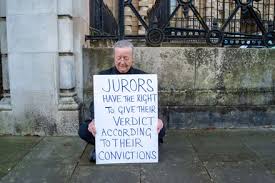
Addressing Mental Health Challenges in Law
May 2, 2024
The Student Lawyer Wellbeing Tips
May 3, 2024Trudi Warner was subject to a great deal of press interest in March 2023 after she held up the following sign outside the Old Bailey:-
Jurors have an absolute right to acquit a defendant according to their conscience
The sign was supposedly a protest to the trial of Insulate Britain activists at that time. Whilst the trial was ongoing in March 2023, Ms Warner appeared outside the Old Bailey each morning holding her sign, often before the Jury had arrived. It is central to the case to note that whilst Ms Warner held up the sign so that it was visible to possible jurors and at one point ‘walked alongside’ members of the jury with her sign visible, she did not otherwise engage with those entering the court.
Ms Warner was arrested for contempt of court and brought before HHJ Silas Reid, the Judge presiding over the Insulate Britain trial. Judge Reid did not decide upon the matter that day and instead referred the matter to the Attorney General for a decision on whether Ms Warner could be tried for contempt of court. The focus of this article is that decision.
In the above case, His Majesty’s Solicitor General sought permission from the High Court to institute proceedings for contempt against Ms Warner, contrary to the common law as opposed to proceedings under the Contempt of Court Act 1981 (The distinctions between the two are outside of the scope of this humble article).
Mr Eardley KC, acting for HM Solicitor General, argued that Ms Warner’s actions amounted to direct interference in the administration of justice and contempt regardless of her intention to commit an offence. Her behaviour was alleged to create a real risk that jurors were harassed, intimidated, or otherwise pressured to discharge their obligation to the court.
In addition, Ms Warner’s conduct was aggravated by the fact that the placard improperly stated the law, in that jurors, do not have a ‘right’ to acquit on the grounds of conscience as opposed to having the ‘power’ to acquit.
Ms Montgomery KC, acting for Ms Warner, submitted that Ms Warner’s actions were no more than a reminder to the juries of a long-standing legal principle. There was no other encouragement or persuasion aimed at by the sign, and it cannot be said that Ms Warner harassed, impeded, or otherwise tried to convince any jurors to change their verdicts. During the trial, Judge Reid made a legal direction that the jury was bound to follow the law as he directed and disregard whatever else they may have been told – a direction which was more than sufficient to remedy any impact that Ms Warner had on proceedings.
Ms Montgomery highlighted that the placard was no more objectionable than a plaque found outside the Old Bailey. The plaque commemorates the jury in Bushel’s Case (1670) 124 ER 1006 for refusing to convict the defendants despite the judge’s direction. The jurors were held in contempt and imprisoned for two days, yet they remained resolute in their stance.
As this was an application for HM Solicitor General for permission to bring contempt proceedings, the applicants had to satisfy the court of two matters:-
- Whether there was a reasonable basis for believing there was an actionable contempt of court and, therefore, to commit the matter for proper deliberation.
- That it is in the public interest for contempt proceedings to be brought.
In deciding that there was no actionable case for contempt of court, Saini J set out his reasons as follows:-
- Ms Warner did not molest, assault, or threaten those participating in proceedings at any point, and therefore, there could not be actionable contempt on those grounds. The common law authorities all set out a requirement of aggression or some sense of provocation, a bar which was simply not met in this case. In essence, Ms Warner acted as a ‘human billboard’ and did nothing further.
- Ms Warner’s placard was merely informative, and her conduct was consistent with information sharing. There is a distinctive difference between inciting or encouraging a jury to acquit on the grounds of conscience and simply informing them of their right to do so. Communicating the bare principle of law to jurors within a public forum was not unlawful.
- The idea that Ms Warner erroneously stated the law by describing jury equity as a ‘right’ rather than a ‘power’, was a distinction without a difference, and to allow criminal proceedings to be brought on this basis would be unconscionable.
- The legal test for the common law of contempt is a serious risk of or actual interference with the administration of justice, and Ms Warner’s conduct did not even come close to meeting this test. The direction given by Judge Reid was more than sufficient to remedy any issues posed by Ms Warner’s conduct.
It was accepted by both advocates and reiterated by the court that jurors are entitled to acquit solely based on the grounds of conscience – this is referred to as “jury equity”. However, this is more accurately described as a power or absurd outcome borne of the legal principles that a judge cannot direct a jury to convict (see R v Wang [2005] 2 Cr App R 8), and a jury is not bound to give reasons for its decision.
In addition, the jury is obliged to follow the directions of law given to them by the judge, and it would be unlawful for participants in the trial process (defence advocates included) to invite a jury to apply jury equity or remind them of their right to do so.
Whilst any comment on this decision may be subject to later revision, the decision in its current stage serves as a reminder of a long-established tradition in English and Welsh law, as well as showing that despite the Government’s rhetoric to the contrary, peaceful protest still has a place within polite society. Following Ms Warner’s arrest, more than 20 other protesters engaged in similar conduct, and those persons would likely have been subjected to contempt proceedings had this case been resolved in the Government’s favour. With the issue of climate change and protest-related offences far from being resolved, whether in this jurisdiction or on the international stage, it will be interesting to see if this ruling leads to a ‘scaling up’ in the level of protest at future trials, and how such protests will be managed by the police and courts.
In particular, should future protests involving people holding such signs involve more direct engagement and/or harassment of the public and jurors instead of simply ‘acting as a human billboard’, it would be unsurprising to see a further question referred to the High Court for consideration.
Written by Charlie Jones





